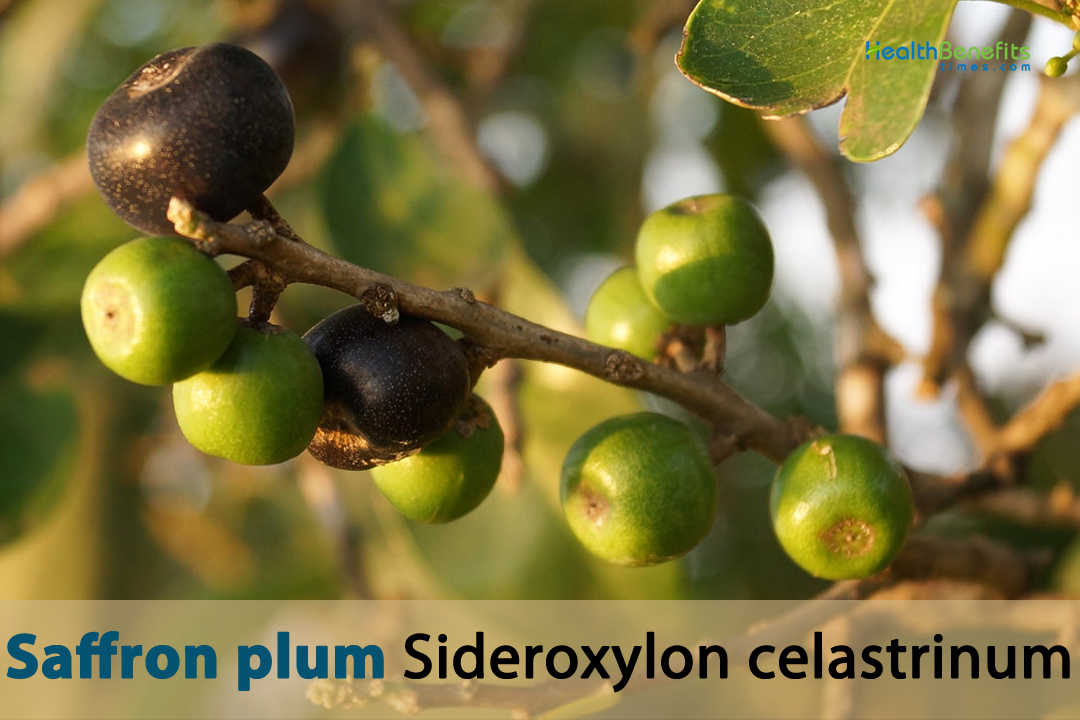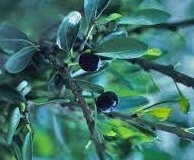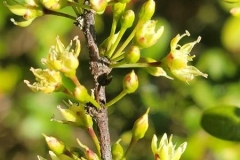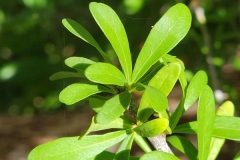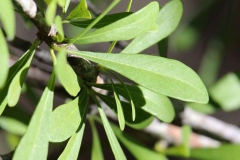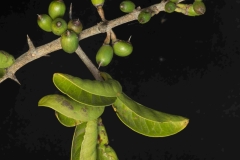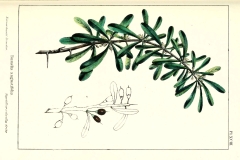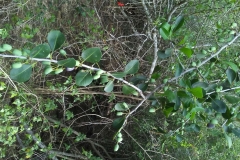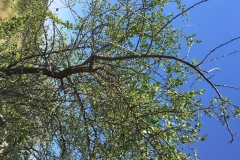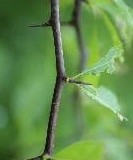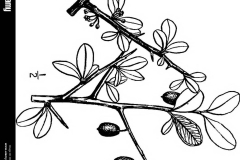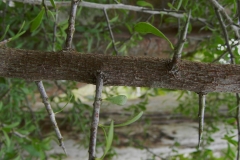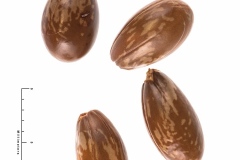The origin of the genus name “Sideroxylon” is a Greek term in which “sideros” signifies “iron” and “xylon” denotes “wood.” This presumably pertains to the strength or rigidity of the wood found in species belonging to the Sideroxylon genus. The genus Celastrus, from which “Celastrinum” is derived, comprises a group of woody plants that are frequently referred to as staff vines or bittersweet. The nomenclature of this plant species might imply a taxonomic or morphological similarity or correlation with plants belonging to the Celastrus genus. Saffron Plums, similar to other varieties, possess vitamin, mineral, and antioxidant content. In addition to vitamin C, vitamin K, and potassium, they comprise dietary fiber and are therefore a nutritious addition to the diet.
Saffron Plum Facts
| Saffron plum Quick Facts | |
|---|---|
| Name: | Saffron plum |
| Scientific Name: | Sideroxylon celastrinum |
| Origin | Texas and Florida in the United States south through Central America to northern Venezuela and Colombia in South America |
| Colors | Initially green that ripens dark purple or black color |
| Shapes | Small, round drupes that typically measure around 1/2 inch in diameter |
| Flesh colors | Creamy white or pale yellow |
| Taste | Sweet and mildly tangy |
| Major nutrients | • Vitamin C • Dietary Fiber • Carbohydrates • Antioxidants • Potassium • Calcium • Magnesium |
| Name | Saffron plum (Yellow Mastic) |
|---|---|
| Scientific Name | Sideroxylon celastrinum |
| Native | Texas and Florida in the United States south through Central America to northern Venezuela and Colombia in South America |
| Common Names | Yellow Mastic, Yellow berry, False Mastic, Yellow heart, Yellow Mastic berry, Red berry Stopper, Yellow Sapodilla, Florida Bully, Shiny Leaf Jonas, Yellow Stopper, Coast Stopper |
| Name in Other Languages | Afrikaans: Geel Masticboom Albanian: Mastic i verdhë Amharic: Birez Mastic (ቢረዝ መስቲክ) Angika: Pilā Mastik (पिला मस्तिक) Arabic: Mutaat Asfar (مطاط أصفر) Armenian: Yellow Mastic Assamese: Holodi Mestik (হলদি মেস্টিক) Aymara: Yellow Mastic Azerbaijani: Sarı Mastic Basque: Mastic hori Bengali: Haluda māsṭika (হলুদ মাস্টিক) Bhili: Pilā Mastik (पिला मस्तिक) Bhojpuri: Pilā Mastik (पिला मस्तिक) Burmese: Yellow Mastic Catalan: Masteguer groc Chinese: (Huángsè shù jiāo (黄色树胶) Croatian: Žuti Mastik Czech: Žlutý Mastek Danish: Gul Mastic Dhivehi: Yellow Mastic Dogri: Pīlā Mastik (पीला मस्तिक) Dutch: Gele Mastic English: Yellow Mastic, Bumelia, Saffron plum, Narrow-leafed Iron wood, Tropical buckthorn, antswood, downward plum, milk buckthorn, tropical plum Estonian: Kollane Mastiks Filipino: Dilaw na Mastik Finnish: Keltainen Mastic French: Mastic jaune Galician: Mástique amarelo Garhwali: Pilā Mastik (पिला मस्तिक) Georgian: Yellow Mastic German: Gelber Mastix Greek: Kitrino mastíchi (Κίτρινο μαστίχι) Guarani: Yellow Mastic Gujarati: Pīḷuṁ Mastic (પીળું માસ્ટિક) Hausa: Mastic Mai karfi, Babbayi Hawaiian: Lehua māpu Hebrew: Mastik tzahov (מסטיק צהוב) Hindi: Pīlā masṭik (पीला मस्टिक) Hungarian: Sárga Mastic Indonesian: Mastic Kuning Inuktitut: Yellow Mastic Igbo: Mastic Odo Italian: Mastice giallo Japanese: Lerō masutikku (イエローマスティック) Kannada: Haḷadi Mastic (ಹಳದಿ ಮಾಸ್ಟಿಕ್) Kashmiri: Pīl Masṭik (پیل مسٹک) Kazakh: Sarı Mastik Khmer: Yellow Mastic Konkani: Pivla Mastik (पिवळा मस्तिक) Kumaoni: Pilā Mastik (पिला मस्तिक) Kurdish: Mastîk rengê zer Kurukh: Hāli Mastik (हालि मस्तिक) Kyrgyz: Sarı Mastic Lao: Yellow Mastic Latvian: Dzeltenais Mastiks Lithuanian: Geltonas Mastikas Maithili: Pilā Mastik (पिला मस्टिक) Malay: Mastic Kuning Malagasy: Mastic Manga Malayalam: Mañña Māsṟṟikk (മഞ്ഞ മാസ്റ്റിക്ക്) Maldivian: Yellow Mastic Maltese: Mastik Iż-Żejt Manipuri: Holodi Mestik (হলদি মেস্তিক) Mapudungun: Yellow Mastic Marathi: Pivaḷaṁ Mastic (पिवळं मास्टीक) Meitei: Holodi Mestik (হলদি মেস্তিক) Mongolian: Yellow Mastic, Shar mastic (Шар мастик) Myanmar (Burmese): Yan-Yi-Shawng-Tee (ရန်းရည်ရှောင်တီး) Nahuatl: Yellow Mastic Navajo: Yellow Mastic Nepali: Pahēlō Māsṭika (पहेलो मास्टिक) Norwegian: Gul Mastikk Odia: Haladi Mastik (ହଳଦି ମସ୍ତିକ) Pashto: Zamray Mastic (زمرې ماسټيکه), Zer Mastic (زر ماسټک) Polish: Żółty Mastyks Portuguese: Mástique amarelo Punjabi: Pīlā Māsaṭik (ਪੀਲਾ ਮਾਸਟਿਕ) Quechua: K’urinku Mastic Romanian: Mastic galben Russian: Zheltyy mastika (Желтый мастика) Santali: Haldi Mastik (हल्दि मस्तिक) Serbian: Žuta mastika (Жута мастика) Sindhi: Pīlō Masṭik (پيلو مسٽڪ) Sinhala: Daruvā Malpum (දරුවා හලුවා) Slovenian: Rumena mastic Somali: Mastic Cas Spanish: Mastic Amarillo, coma, pionche Sundanese: Yellow Mastic Swahili: Mafuta ya Manjano Swazi: Isivunvu Sengamagagula Swedish: Gul Mastix Tahitian: Mastic Uta Tajik: Mastici Safed, Mastikai safed (Мастикаи сафед) Tamil: Manjaḷ Mastic (மஞ்சள் மாஸ்டிக்) Telugu: Pasupu Mastic (పసుపు మాస్టిక్) Thai: S̄ī h̄elụ̄̀xng mā s̄ dìk (สีเหลืองมาสติก) Tibetan: Yellow Mastic Tulu: Haḷadi Mastik (ಹಳದಿ ಮಸ್ತಿಕ್) Turkish: Sarı mazı Turkmen: Sary Mastic Ukrainian: Zholtyy mastyk (Жовтий мастик) Urdu: Pila Lakh (پیلا لاکھ) Uzbek: Oq Mastic, Sari Mastic Vietnamese: Mastic Vàng Xhosa: I-Mastic yomzimba Yoruba: Omi Mastic Dudu| Zulu: Umthombo Wezandla |
| Plant Growth Habit | Small, dry deciduous spiny shrub or small tree |
| Growing Climates | Thickets, marshes, coastal hammocks, salt flats, plains, prairies, coastal strands, coastal rock barrens, rock land hammock edges, orchards, home gardens, woodland areas, hedgerows, riverbanks, mixed orchards, mountainous areas |
| Soil | Well-drained soil is essential for Saffron Plum trees to prevent waterlogging, which can lead to root rot. The soil should be loamy and fertile, with a pH level ideally between 6.0 and 7.0. |
| Plant Size | 2–9 m (6.6–29.5 ft) |
| Root | Fibrous roots that spread out horizontally in the soil, forming a dense network of fine roots. These roots serve to anchor the tree securely in the ground and absorb water and nutrients from the soil |
| Stem | Sturdy and woody, providing structural support for the tree’s branches and foliage |
| Bark | Dark brown-gray, smoother on young trees, fissured to blocky on mature trees |
| Leaf | Simple, alternate, and ovate to elliptic in shape. They have a glossy, dark green color on the upper surface and a lighter green color on the lower surface. The margins of the leaves are usually smooth, although they may occasionally be slightly serrated |
| Flowering season | March or April |
| Pollinators |
|
| Flower | Small, creamy white to pale yellow in color, and typically appear in clusters. Each flower has five petals and a central cluster of stamens, which are the male reproductive organs that produce pollen |
| Fruit Shape & Size | Small, round drupes that typically measure around 1/2 inch in diameter |
| Fruit Color | Initially green that ripens dark purple or black color when mature |
| Fruit Skin | Smooth skin |
| Flesh Color | Creamy white or pale yellow in color |
| Fruit Weight | 5 to 15 grams (approximately 0.18 to 0.53 ounces) per individual fruit |
| Seed | Typically oval-shaped and have a smooth surface |
| Flavor/Aroma | Sweet and mildly fragrant |
| Taste | Sweet and mildly tangy |
| Plant Parts Used | Bark, leaves and fruits |
| Propagation |
|
| Lifespan | Around 50 to 100 years or more |
| Season | August to September |
| Major Nutrition |
|
| Available Forms |
|
Plant Description
At full maturity, the saffron plum is a diminutive, arid deciduous spiny shrub or tree that can attain a height of 10 to 20 feet (3 to 6 meters) and a width of 10 to 15 feet (3 to 4.5 meters). However, some varieties may be smaller or larger, and the size and shape of the tree can also be altered through appropriate pruning. Thickets, marshes, coastal hammocks, salt flats, plains, prairies, coastal strands, rock land hammock edges, woodland regions, hedgerows, riverbanks, mountainous regions, and mixed plantations are all habitats where this plant is observed to thrive. The plant prefers waterlogged soil that is well-drained. Prefers a loamy, fertile soil that possesses a pH range of 6.0 to 7.0.
The saffron Plum fruits possess a wide range of culinary applications, encompassing jams, jellies, baked products, and pies. Their sweet and sour flavor makes them highly valued, and they are frequently consumed fresh or preserved. Ornamental attributes such as vibrantly colored fruits, glossy green foliage, and fragrant blossoms are highly esteemed in trees. Due to their aesthetic allure, they are frequently incorporated into landscaping projects, parks, gardens, and gardens. Birds, rodents, and other wildlife find fruits exceptionally appetizing, which contributes to their significance as a food source for local ecosystems. Historically, Native American tribes fashioned bows, arrows, and various implements from the timber. Additionally, the bark and foliage were utilized for medicinal intents.
Roots
In general, the Saffron Plum tree’s roots are composed of an interconnected system of fibrous structures. These roots extend horizontally throughout the soil, frequently surpassing the tree’s canopy. They function to provide the tree with a secure foundation in the soil and to extract nutrients and water from the soil. Various factors can influence the depth and extent of the roots, including soil conditions, moisture content, and nutrient availability. In their entirety, the roots of the Saffron Plum are of paramount importance in sustaining the tree’s vitality and development.
Stem
Typically robust and composed of timber, the stem provides support for the tree’s branches and foliage. The structure comprises multiple strata, which comprise the phloem, cambium, bark, and xylem. The outer epidermis functions as a defensive barrier against pathogens and environmental stresses, whereas the cambium layer initiates the process of tissue regeneration. The xylem transports minerals and water from the roots to the remainder of the tree via the stem, whereas the phloem transports sugars produced during photosynthesis to various portions of the tree in order to provide energy and facilitate growth. As it reaches maturity, the stem of the Saffron Plum may acquire a discernible grayish-brown hue and a unique texture.
Bark
Young bark is typically smooth and grayish-brown in color; as it ages, it becomes progressively coarser and darkened. It is composed of multiple strata. The outermost stratum, which safeguards against physical harm, infestation by parasites, and environmental pressures such as excessive heat and moisture depletion. Over an extended period, a corky layer may form beneath the outermost bark, thereby enhancing the bark’s protective barrier. The innermost stratum of the bark, comprised of viable cells that are accountable for the conveyance of carbohydrates generated via photosynthesis from the leaves to various locations on the tree in order to provide energy and facilitate growth.
Leaves
Typically, the foliage consists of simple, alternate, ovate to elliptic leaves. The upper surface is glossy and dark green, while the lower surface is a paler shade of green. While the leaf margins are typically smooth, they may be marginally serrated on occasion. The leaves are positioned alternately along the branches; that is, they are not positioned precisely opposite one another but rather in a staggered fashion along the stem. The prominent midrib and lateral veins of each leaf aid in the distribution of nutrients and water.
Before falling from the tree in the autumn, the leaves may undergo a color change to yellow, orange, or red. This contributes to the tree’s aesthetic appeal in the landscape and offers visual appeal throughout the seasons. In addition to enhancing the tree’s visual appeal, its leaves facilitate photosynthesis, the mechanism through which it converts solar energy into usable energy.
Flowers
Clusters of tiny, pale yellow to creamy white flowers are the typical phenotype. Every individual flower consists of five petals and a cluster of stamens, the pollen-producing male reproductive organs, in the center. Frequently, the blossoms’ fragrance entices pollinators, including butterflies and bees. Spring is when saffron plum trees typically produce their fragrant and vibrant blossoms, which adorn the landscape. In general, the flowers assume a significant role in the tree’s life cycle by enticing pollinators and ultimately maturing into the fruits, which encompass the tree’s seeds.
Fruits
Fruits are typically round, diminutive drupes with a diameter of about 1/2 inch. Smooth in texture, their mature epidermis transforms from green to dark purple or black. Every fruit is composed of a solitary seed that is encased in a rigid stone or pit. The edible fruits have a flavor that is both sweet and sour. They are frequently consumed uncooked or incorporated into desserts, preserves, and jellies, among other culinary preparations. In addition, the fruits attract birds and other fauna, which aids in seed dispersal and tree propagation.
Seeds
A rigid stone or crevice is present within the fruit to enclose the seeds. Typically, these seeds possess an oval morphology and a glossy exterior. Depending on the particular cultivar of Saffron Plum tree, they differ in size.
Culinary Uses
- Fresh Consumption: Fresh mature fruits are edible and impart a flavor that is both sweet and sour. They are nutritious snacks that can be consumed on their own or incorporated into fruit concoctions to enhance the taste and consistency.
- Preserves and Jams: The saffron Plums are frequently incorporated into fruit compotes, sauces, and preserves. By reducing them to a syrup, one can produce a delectable spread that is suitable for spreading on crackers, toast, or in conjunction with cheese.
- Baking: The inclusion of the fruits in a variety of baked products, including pies, cobblers, and muffins, is possible. Their delectable sweetness imparts an unexpected delight to conventional baked dishes.
- Sauces and Syrups: The saffron Plums may be reduced in temperature to produce syrups and sauces that are drizzled over ice cream, pancakes, waffles, or used as a dessert garnish.
- Flavoring: Lemonades, teas, and cocktails may incorporate the liquid of Saffron Plum fruits as an all-natural flavoring agent. It imparts a distinct and invigorating flavor to beverages.
Other Uses
- Ornamental: Valued for their aesthetically pleasing foliage, fragrant blossoms, and vibrant fruits are saffron plum trees. Aesthetic enhancement of outdoor spaces is frequently achieved through their planting in parks, gardens, and landscaping endeavors.
- Wildlife Habitat: Wildlife, including birds and rodents, consider the fruits of the Saffron Plum tree to be a valuable food source. In natural areas, planting Saffron Plum trees can aid in attracting and sustaining diverse wildlife populations.
- Woodworking: Although not utilized as frequently as the wood of other tree species, the Saffron Plum tree’s wood can be utilized for woodworking endeavors. Due to its moderate hardness and durability, it can be utilized to fashion small crafts, handles, and ornamental objects.
- Environmental Benefits: As with other tree species, Saffron Plum trees reduce soil erosion, improve air quality, and sequester carbon, all of which are beneficial to environmental health. In particular, their expansive root systems aid in preventing erosion and stabilizing soil in riparian zones.
- Cultural Significance: Saffron plum trees are imbued with symbolic or ceremonial importance in certain cultures. Planting them to commemorate special occasions, incorporating them into traditional rituals, or holding them in high regard for their historical and cultural significance are all possible intentions.
Side effects
- Allergic Reactions: Acute fruit or tree nut allergies may manifest in individuals who are sensitive to saffron plum fruits. Slight manifestations of inflammation or pruritus may coexist with more severe responses like respiratory distress or anaphylaxis.
- Toxicity: Although the fruits are consumable, it is possible that certain components of the Saffron Plum tree, including the foliage, bark, or seeds, may comprise toxic substances when consumed in significant amounts. It is critical to handle these tree parts with care and to refrain from ingesting them.
- Digestive Issues: The consumption of Saffron Plum fruits in excessive amounts may induce digestive distress in certain individuals, including symptoms such as gas, bloating, or diarrhea. The key to avoiding such issues is moderation.
- Pesticide Residues: Pesticide residues may be present in Saffron Plum fruits that are not cultivated organically or adequate cleansed prior to consumption. Prolonged ingestion of such fruits could potentially result in adverse health effects. It is recommended to cleanse fruits meticulously and, whenever feasible, choose organic produce.
- Interaction with Medications: It is advisable for individuals who are currently taking specific medications or supplements to seek guidance from a healthcare professional prior to incorporating Saffron Plum fruits into their diet. This is due to the potential for drug interactions that could impact the effectiveness or metabolism of the medications.
References:
https://www.itis.gov/servlet/SingleRpt/SingleRpt?search_topic=TSN&search_value=505216#null
https://www.cabidigitallibrary.org/doi/10.1079/cabicompendium.10351
https://gd.eppo.int/taxon/BUMCE
https://en.wikipedia.org/wiki/Sideroxylon_celastrinum
https://plants.sc.egov.usda.gov/home/plantProfile?symbol=SICE2


